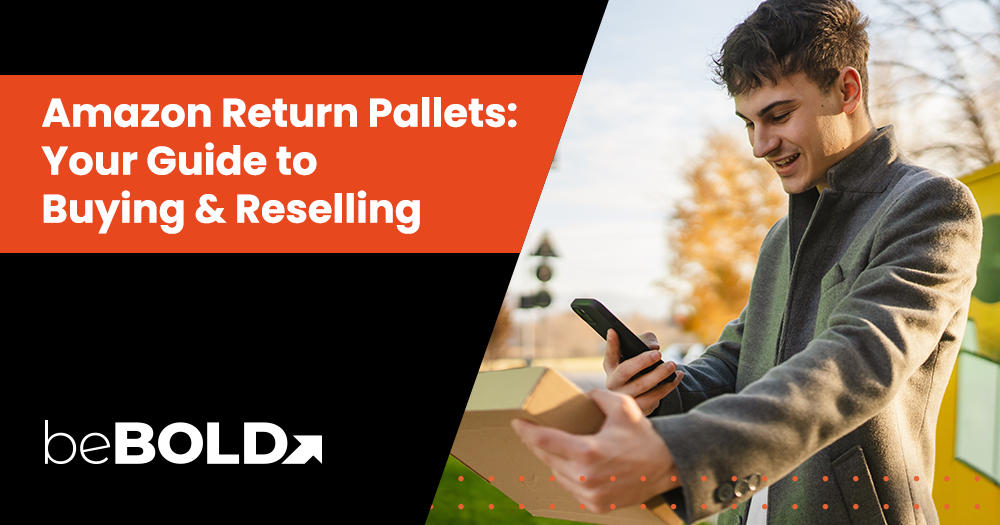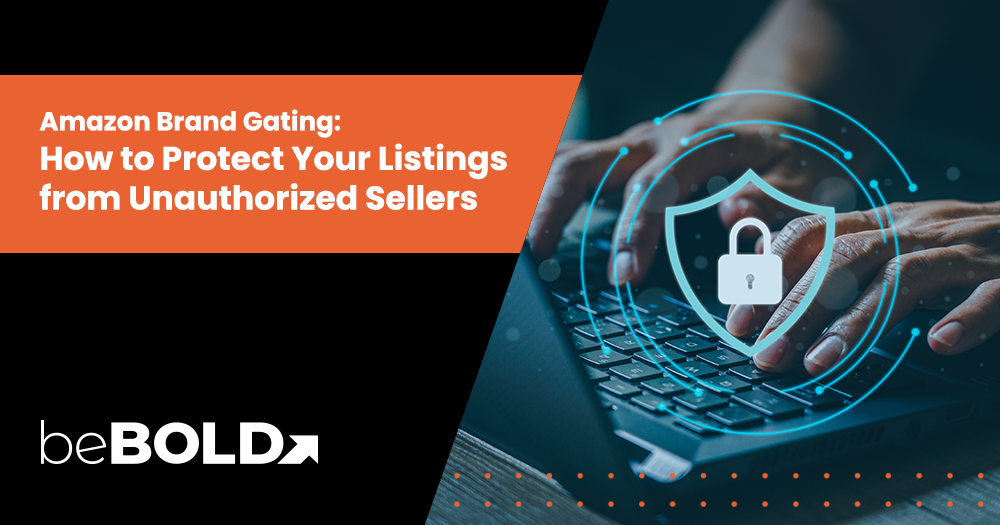Key Highlights
- Amazon return pallets contain customer returns, overstock, or unsold items sold in bulk at discounted prices, offering resale potential for savvy entrepreneurs
- These pallets are cheaper than regular wholesale but come with risks like damaged goods or mixed-quality inventory
- You can buy them from Amazon’s own liquidation programs or trusted third-party sites—always verify the legitimacy before purchase
- Understanding manifests, shipping costs, and storage needs is essential to avoid hidden expenses
- Smart buyers inspect, refurbish, and repackage items to increase their resale value and credibility
- Platforms like eBay, Facebook Marketplace, and Amazon itself are top channels to flip returned goods
- Success depends on solid pricing, effective marketing, and legal compliance including proper licenses and tax obligations
- Partnering with eCommerce experts like BeBold Digital helps streamline the resale process and scale your business profitably
Amazon return pallets, consisting of returned, overstock, or unsold items, are a popular choice for resellers seeking affordable inventory. Sold at a fraction of their retail value, they offer opportunities in categories like electronics and home goods.
This guide will teach you how to source, evaluate, and profit from Amazon return pallets, whether you're starting a side hustle or growing a liquidation business.
Understanding Amazon Return Pallets

What Are Amazon Return Pallets?
Amazon return pallets are bulk lots of customer-returned, overstock, or unsold products sold at discounted prices. These pallets offer resellers an opportunity to purchase goods in bulk for resale.
Return pallets are typically made up of a mix of returned items, overstock, and unsold merchandise. The products can range from new and unopened to lightly used, depending on the return reason.
Common product categories included
Common categories in return pallets include selling Beauty products, Electronics, Home goods, Clothing, and Toy items.
Amazon Return Pallets vs. Regular Wholesale Pallets

Amazon return pallets include customer returns, overstock, or unsold items, often at a steep discount, with varying conditions from new to used.
In contrast, regular wholesale pallets contain brand-new, unopened items, offering consistent quality but at a higher price due to predictable demand and perfect condition.
Here’s a comparison table to help you distinguish between Amazon return pallets and regular wholesale pallets:
|
Feature |
Amazon Return Pallets |
Regular Wholesale Pallets |
|
Source of Goods |
Customer returns, overstock, liquidation |
Direct from manufacturers or distributors |
|
Condition of Items |
Mixed (new, used, damaged, or refurbished) |
Typically new and in perfect condition |
|
Pricing |
Deeply discounted |
Wholesale pricing (still below retail) |
|
Profit Potential |
High, but depends on repair/refurbishment capability |
More predictable, lower risk |
|
Risk Level |
Higher due to item variability |
Lower, with consistent product quality |
|
Best For |
Resellers comfortable with refurbishing and sorting |
Retailers seeking ready-to-sell inventory |
Reasons for Returns
Amazon return pallets often contain items that have been returned by customers for a variety of reasons. Understanding these reasons can help resellers assess the potential value and risk of purchasing these pallets.
Customer Dissatisfaction
One of the most common reasons for returns is customer dissatisfaction. This could be due to incorrect product expectations, sizing issues, or simply a change of mind after purchase.
Shipping Damages
Items can be returned due to damage that occurred during shipping. These products may still be resellable, but the condition may require repairs or discounted pricing to attract buyers.
Overstock
Retailers and manufacturers often return excess inventory that didn’t sell in time, leading to overstock. These items are typically in new condition and can offer resellers an opportunity to sell popular products at a lower price.
Benefits of Purchasing Return Pallets
Purchasing Amazon return pallets can offer resellers several advantages, from cost savings to diverse Amazon inventory options and even sustainability benefits.
Cost Savings
Amazon return pallets are typically sold at a fraction of their retail value. While the cost varies depending on the condition and category of the products, resellers can often find pallets priced between 10-30% of the original retail price, offering significant savings compared to buying new stock.
Inventory Variety
Return pallets provide a diverse range of products, from electronics to clothing, home goods, and more. This variety allows resellers to cater to multiple markets and reduce the risk of stocking only one type of item.
Sustainability Aspects
By purchasing return pallets, resellers contribute to sustainability efforts by repurposing products that might otherwise end up in landfills. This process helps reduce waste and supports a circular economy by giving items a second life.
Where to Buy Amazon Return Pallets?

Amazon return pallets can be sourced from Amazon’s liquidation platforms or trusted third-party sellers. Always choose reputable sellers with positive reviews, verify their authenticity, and assess product condition before buying.
Official Amazon Liquidation Platforms
Finding reliable sources to purchase Amazon return pallets is crucial for resellers looking to maximize their profits. There are several official platforms that provide access to these pallets such as
- Amazon Liquidation Auctions
- Amazon Bulk Liquidations Store
- Third-Party Liquidation Companies
- Direct Liquidation
- BULQ
- Liquidation.com
- 888Lots
- B-Stock
Amazon Liquidation Auctions
Amazon Liquidation Auctions is a platform where resellers can bid on pallets of returned and excess inventory. These auctions feature a wide range of product categories, from electronics to home goods, and offer the chance to buy in bulk at competitive prices.
Amazon Bulk Liquidations Store
The Amazon Bulk Liquidations Store allows resellers to purchase large quantities of returned, overstock, or excess items directly. This platform provides a more straightforward buying process compared to auctions, offering pallets in a fixed-price format.
Third-Party Liquidation Companies
Several third-party liquidation companies specialize in offering Amazon return pallets. These companies source inventory from various channels, providing resellers with a range of options to explore.
Direct Liquidation
Direct Liquidation is a popular liquidation platform where resellers can buy pallets of returned items, overstock, and liquidation goods. They offer various categories, including electronics, apparel, and home goods, all sourced directly from major retailers like Amazon.
BULQ
BULQ provides resellers with bulk inventory options, including Amazon return pallets, through a simple online platform. They offer detailed product manifests and a wide range of categories, helping resellers make more informed purchasing decisions.
Liquidation.com
Liquidation.com is a well-known auction platform that specializes in bulk liquidation sales. Resellers can find Amazon return pallets here, along with pallets from other retailers. The site features an auction-style bidding system, allowing users to purchase at competitive prices.
888Lots
888Lots is a liquidation company offering Amazon return pallets and other inventory types. They provide detailed manifests and cater to both small-scale resellers and larger liquidation businesses, ensuring a wide range of purchasing options.
B-Stock
B-Stock connects resellers to a network of liquidation and return pallet sellers, including Amazon. The platform operates through online auctions, giving buyers access to pallets at competitive prices while allowing them to choose from a variety of product categories.
How to Identify a Legit Supplier vs a Scam Site
Not all return pallet sellers are legitimate. With scam sites on the rise, knowing how to spot red flags can save you time, money, and frustration.
Comparison Table:
|
Feature |
Legit Return Pallet Supplier |
Scam Website |
|
Website Security |
Uses HTTPS (secure connection) |
Often lacks HTTPS or uses unsecured connection |
|
Contact Information |
Clear, verifiable (email, phone, address) |
Vague or missing contact details |
|
Customer Reviews |
Consistent, credible reviews across platforms |
Few, fake, or overwhelmingly negative reviews |
|
Pricing |
Reasonable, with transparency on product condition |
Unrealistically low prices without product details |
|
Online Presence |
Active on social media, has professional website |
Little to no online footprint |
|
Return/Refund Policy |
Clear and accessible |
Nonexistent or intentionally vague |
|
Overall Transparency |
Detailed info about pallets and sourcing |
Lacks specifics, relies on hype or urgency tactics |
While the opportunity to buy Amazon return pallets is enticing, it's important to stay vigilant and avoid falling victim to fraudulent websites. Scammers often set up fake liquidation sites to deceive resellers into paying for non-existent or misrepresented goods.
Online Marketplaces
Online marketplaces like eBay and Facebook Marketplace are popular sources for purchasing Amazon return pallets. While these platforms offer convenience, it's essential to verify the legitimacy of the listings and sellers.
eBay
eBay offers a wide variety of Amazon return pallets, often through auction-style listings. Resellers can find diverse product categories, but it’s important to carefully check the seller’s ratings, reviews, and return policies. Be cautious of listings with unusually low prices or limited information about the products.
Facebook Marketplace
Facebook Marketplace provides local access to Amazon return pallets, often sold by individuals or small-scale resellers. While it can be a great place to find good deals, it’s crucial to meet sellers in person, inspect the pallets, and ensure they provide clear product details before making any transactions. Always verify the seller’s credibility by checking their profile and history on the platform.
Local Sources
Local sources can provide excellent opportunities for purchasing Amazon return pallets. Warehouse sales and retail store closures often offer significant deals on bulk inventory.
Warehouse Sales
Warehouse sales are a great local option for purchasing Amazon return pallets. These sales often feature excess inventory, overstock, or customer returns at discounted prices. Be sure to arrive early to get the best selection, and check the condition of the pallets before committing to a purchase.
Retail Store Closures
When retail stores close or go out of business, they often liquidate their remaining inventory, including returned and unsold products. This can be an excellent opportunity to purchase Amazon return pallets at a low cost. Keep an eye on local businesses and follow news of store closures to take advantage of these sales.
Best Times of Year to Buy Return Pallets

Timing plays a significant role in the quality and value of Amazon return pallets. Certain times of year offer better opportunities to find high-quality inventory, particularly following peak shopping seasons.
Here are the prime times to buy:
|
Time of Year |
Why It’s a Good Time |
|
Post-Holiday Season |
After major holidays (especially Christmas), returns surge, leading to a flood of high-quality return pallets. |
|
January & February |
Retailers clear out excess inventory; liquidation sales spike. |
|
Back-to-School Season (Aug–Sept) |
Return volumes rise as consumers exchange or return items like electronics and clothing. |
|
End of Fiscal Quarters |
Companies push to offload unsold stock to clean up books, increasing pallet availability. |
|
Mid-Year Sales Events (e.g., Prime Day) |
Return rates rise after major online sales, resulting in more pallets hitting the market. |
|
Black Friday/Cyber Monday Aftermath |
High order volumes mean high return volumes—great for sourcing new or barely used items. |
Buying during these peak windows can give you better product variety, higher item quality, and a competitive edge in resale.
Evaluating and Purchasing Return Pallets

Success starts with smart buying. Know how to read pallet manifests, weigh costs, and handle logistics. The goal isn’t just to buy—it's to make informed choices that maximize resale potential and minimize risk.
Understanding Pallet Manifests
Pallet manifests are detailed lists of the products included in a return pallet. These manifests are crucial for resellers as they help assess the potential value of the inventory and make informed purchasing decisions.
How to Read and Interpret Item Lists
When reviewing a pallet manifest, focus on the product name, quantity, SKU, and condition notes. Some manifests include the original retail price or estimated value. Look for abbreviations like "AS-IS" or "No Refunds" and cross-reference them with the pallet’s overall value to assess if it's a good investment..
Assessing Product Conditions: New, Like-New, Used, Salvage
Pallet manifests will often specify the condition of each item. Here’s what to look for:
- New: Items are brand-new, unopened, and in perfect condition. These are the most valuable and easy to resell.
- Like-New: Items that have been opened but show no signs of use or damage. They are often customer returns that were never actually used.
- Used: These items may show signs of wear and tear, such as scuff marks or minor damage. Reselling these requires more effort in cleaning, testing, or refurbishing.
- Salvage: These items are often damaged or non-functional and may need repairs or be sold for parts. Salvage items are typically the least valuable, though they can still be profitable if you have the skills to repair or repurpose them.
Cost Considerations
When buying Amazon return pallets, consider the upfront cost, shipping, and any repair expenses to determine a viable investment.
Pricing Strategies and Budgeting
Set a budget that includes the pallet cost and potential extra expenses. Create a pricing strategy that balances acquisition costs with the desired profit margin.
Calculating Potential Profit Margins
Estimate the resale value of the pallet items, subtract all costs, and calculate your gross profit. A higher margin indicates a more profitable investment.
Shipping and Logistics
Shipping and logistics play a crucial role in the overall profitability of purchasing Amazon return pallets, as these costs can quickly add up.
Estimating Shipping Costs
Shipping costs depend on factors like pallet size, weight, and destination. Always factor in these costs before purchasing to ensure they don’t eat into your profits. Getting quotes from shipping carriers can help you estimate these expenses accurately.
Handling and Storage Requirements
Handling and storing return pallets require space and organization. Ensure you have the necessary storage area to accommodate bulk pallets. Additionally, consider the labor required for sorting, inspecting, and possibly refurbishing the items before resale.
Tools to Analyze Profitability
To accurately assess the profitability of Amazon return pallets, various tools can help you calculate potential margins, compare pricing, and track expenses.
If you want to go deeper into evaluating bulk liquidation opportunities beyond standard Amazon returns, our Electronic Liquidation Pallets guide breaks down how these loads work, what to watch out for, and how to protect your margins before you buy.
Spreadsheets
Using spreadsheets (like Excel or Google Sheets) allows you to track the costs and sales of each pallet. You can easily calculate profit margins, compare costs to resale values, and track any additional expenses like shipping or repairs.
ROI Calculators
Online ROI (Return on Investment) calculators help estimate the profitability of your purchases. By entering your costs and expected sales prices, these tools provide a quick view of your potential return. Some platforms even have specific calculators for liquidation and pallet purchases.
Marketplaces to Compare Pricing
Marketplaces like eBay, Amazon, and other resale platforms allow you to compare prices for similar items in real-time. By researching prices and competition, you can better estimate potential resale values for the products in your pallets.
Reselling Strategies for Maximum Profit
After securing return pallets, inspect and refurbish items, select the right sales platforms, set competitive prices, and market effectively to maximize profits. Here's more on it.
Product Inspection and Refurbishment
Thoroughly inspecting and refurbishing items from return pallets can significantly boost resale value and reduce customer complaints.
Assessing Item Functionality
After unpacking a pallet, check each item for damage, missing parts, or defects. Test electronics and appliances to ensure they work properly before listing them for resale.
Repairing or Repackaging Goods
Minor repairs—like fixing loose parts or replacing batteries—can make used items sellable. Repackaging products in clean, presentable boxes also improves buyer trust and perceived value.
Choosing Sales Channels
Checking and improving item condition is key to increasing resale value and customer satisfaction.
Assessing Item Functionality
Test each item to ensure it works as expected. Check for damage, missing parts, or wear—especially with electronics and appliances.
Repairing or Repackaging Goods
Fix minor issues where possible, like loose components or dead batteries. Clean and repackage items neatly to boost buyer confidence and presentation.
Selecting the right sales channels helps you reach the ideal customers and optimize profit from return pallet items. Your choice depends on the product type, condition, and how hands-on you want to be with the selling process.
Choosing Sales Channels
Selecting the right sales channels helps you reach the ideal customers and optimize profit from return pallet items. Your choice depends on the product type, condition, and how hands-on you want to be with the selling process.
Online Platforms: Amazon, eBay, Etsy
- Amazon is ideal for new or like-new items, especially electronics, home goods, and branded merchandise. Listings require accuracy and often fulfillment through Amazon FBA for faster shipping.
- eBay works well for used, refurbished, or unique items. You can sell across various conditions, use auction or fixed pricing, and reach a global audience.
- Etsy is great for creatively repackaged items, vintage finds, or anything with a handmade or curated feel. If you turn return items into bundles or upcycled goods, this platform adds value.
Local Sales: Flea Markets, Garage Sales
- Flea markets are perfect for moving inventory fast, especially low-cost, general merchandise. You'll get direct feedback from buyers and avoid shipping hassles.
- Garage sales offer a low-overhead way to clear out large volumes of lower-value or mixed-condition items while connecting with local bargain hunters.
Pricing and Marketing
To move return pallet inventory efficiently, you need smart pricing and compelling product presentation that attracts buyers and builds trust.
Competitive Pricing Strategies
Research similar products on platforms like Amazon and eBay to set competitive prices. Consider item condition, demand, and shipping costs. For used or refurbished goods, undercutting new-item prices slightly can help you sell faster while still making a solid margin.
Effective Product Listings and Descriptions
Write clear, honest titles and descriptions that highlight key features, item condition, and any defects. Use high-quality photos taken from multiple angles. Transparency builds buyer confidence and reduces the risk of returns or complaints.
Legal and Ethical Considerations
When exploring Amazon return pallets, it's crucial to consider legal and ethical aspects, such as obtaining business licenses, meeting tax obligations, and following consumer protection laws. These steps ensure a legitimate, responsible business that builds trust and supports long-term success.
Business Licensing and Taxes
To operate legally and maximize profit when reselling Amazon return pallets, it’s essential to understand business licenses, permits, and analyzing sales tax reports.
Obtaining Necessary Permits
Check with your city or state to see if you need a resale license, seller’s permit, or business registration. These documents allow you to legally collect sales tax and buy inventory without paying retail tax.
Understanding Tax Obligations
Keep records of all purchases, sales, and expenses. You may be required to collect and remit sales tax, depending on your location and sales channels. Consult an accountant or tax advisor to ensure you're filing correctly and taking advantage of any eligible deductions.
Consumer Protection Laws
Adhering to consumer protection laws is essential for customer satisfaction and long-term business success. It involves offering refunds, providing accurate product descriptions, and honoring warranties.
Ensuring Product Safety and Compliance
Before reselling toy items, electronics items, or health-related items, ensure they meet safety standards and aren’t subject to recalls. Check for required labels, expiration dates, or certifications where applicable.
Handling Returns and Customer Complaints Ethically
Clearly state your return policy in each listing. When issues arise, respond promptly and professionally. Offering refunds or replacements when appropriate not only complies with platform rules but also strengthens your seller reputation.
Challenges and Risk Management

Buying and reselling Amazon return pallets comes with challenges, including handling returns, logistics, and varying product conditions. Success depends on strategic risk management, understanding potential pitfalls, and using mitigation strategies to manage these risks effectively.
Common Pitfalls
Buying Amazon return pallets can seem like a quick way to profit, but it’s not without its downsides. Many sellers run into issues like receiving unsellable or damaged goods, unexpected shipping costs, or unreliable manifests.
1. Receiving Unsellable Items
Not all pallets come with accurate manifests. You may receive damaged, incomplete, or low-demand items. Always buy from reputable sources and, if possible, review manifests or sample photos before purchase.
2. Underestimating Costs
New sellers often overlook extra costs like shipping, storage, repairs, and platform fees. These can quickly eat into profits. Create a detailed budget before buying and factor in a buffer for unexpected expenses.
Mitigation Strategies
To minimize risks when buying Amazon return pallets, start small and build solid relationships with reputable suppliers.
3. Starting with Smaller Purchases
Begin with smaller lots to better understand the quality, costs, and reselling process. This minimizes potential losses as you gain experience.
4. Building Relationships with Reputable Suppliers
Work with trusted suppliers who provide clear manifests and reliable stock. Cultivating these relationships can give you access to better products and deals over time.
Maximize Your eCommerce Success with BeBold Digital
At BeBOLD Digital, we help eCommerce businesses thrive by driving innovative strategies that elevate your online presence. Whether you're looking to scale your Amazon store, boost sales, or optimize your digital marketing, we provide expert solutions tailored to your unique needs.
Our team blends cutting-edge technology with data-driven insights to ensure your success in the competitive eCommerce landscape. Trust BeBold Digital to unlock your brand’s full potential.
Conclusion
Buying and reselling Amazon return pallets can be a profitable business with the right approach. Key takeaways include the potential for discounted inventory, refurbishment opportunities, and contributing to sustainability.
However, challenges like logistics, product condition, and legal requirements must be navigated carefully. To succeed, conduct thorough research, start small, and scale strategically. With smart strategies and a keen eye for value, Amazon return pallets offer a unique and lucrative business opportunity.
Frequently Asked Questions
What is typically included in an Amazon return pallet?
An Amazon return pallet typically includes a variety of items returned by customers or overstocked products. This could range from unopened items to slightly used products across various categories such as electronics, home goods, apparel, and more.
Can I buy Amazon return pallets without a business license?
While anyone can purchase Amazon return pallets, you would need a business license if you plan to resell the items. This could also help you avoid paying sales tax on purchases from wholesalers or other resellers.
Are there risks of receiving counterfeit or broken items?
Yes, there is a risk of receiving counterfeit or damaged items within Amazon return pallets. Thorough inspection and vetting of items is necessary to mitigate such risks and ensure profitable resale.
Is selling Amazon return pallets profitable for beginners?
Selling Amazon return pallets can be profitable for beginners provided they understand the business, invest time into researching and scrutinizing pallets, refurbishing items, setting accurate prices, and effectively managing shipping and logistics.
What are the best marketplaces to resell return items?
Online platforms like eBay and Amazon, as well as local marketplaces and physical retail stores, can be effective spaces for reselling items from return pallets. However, choosing these depends on your business model, the nature, and condition of goods, and customer preferences.
Ready to take your eCommerce business to the next level? Partner with BeBold Digital today and start maximizing your potential. Contact us now for a free consultation!
Get a Free Brand Audit from beBOLD Digital!









Comments